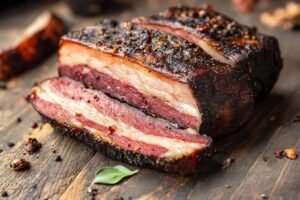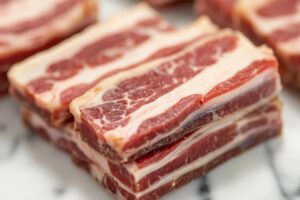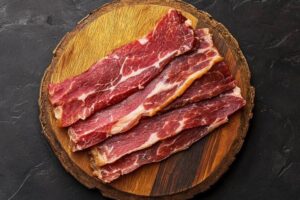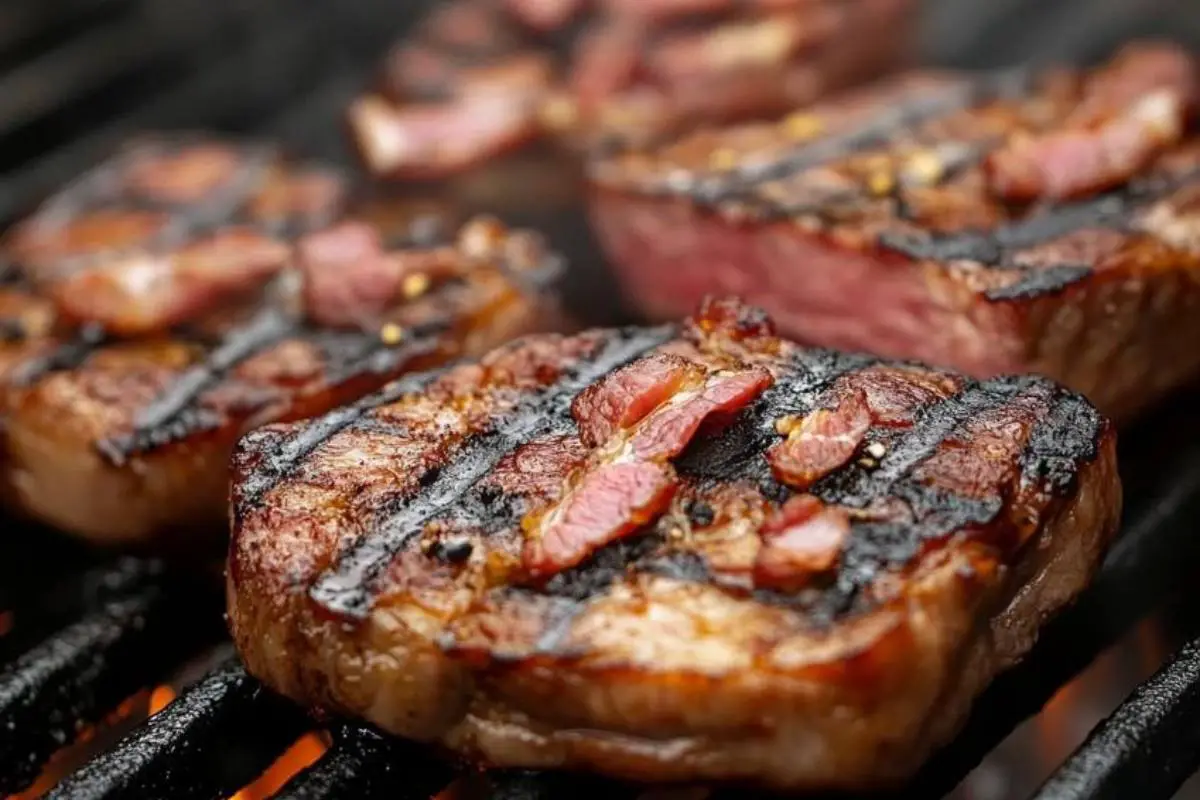When you hear the word bacon, you likely think of the crispy, savory pork bacon that many enjoy as part of breakfast. However, there’s a growing alternative that’s gaining popularity: beef bacon. Whether for religious, health, or personal preferences, people are exploring beef bacon as a delicious substitute. But what exactly is beef bacon, and how does it compare to pork bacon?
In this guide, we’ll explore the origins, ingredients, nutritional facts, and taste of beef bacon. By the end, you’ll understand why it’s a worthy addition to your diet.
What is Beef Bacon Made From?
Beef bacon comes from the belly, navel, or brisket of the cow. These cuts have a high-fat content similar to pork belly, allowing the meat to crisp when cooked. The beef belly is the most common cut, offering a flavor and texture that mimics pork bacon. Some variations use leaner cuts like brisket for those who want a less fatty alternative.
The process for making beef bacon mirrors how pork bacon is prepared. The meat is cured with salt and spices, then smoked or dried. This method infuses a savory, smoky flavor that makes beef bacon a delicious pork alternative.
For a deeper dive into the differences between these types of bacon, check out this comparison guide.
How Beef Bacon Is Made
Making beef bacon is straightforward and involves three key steps: curing, smoking, and slicing.
Step 1: Curing
Curing is the process of rubbing the beef with salt, sugar, and spices like pepper or paprika. The meat absorbs the flavors over several days. This process enhances flavor and preserves the meat.
Step 2: Smoking
After curing, the beef is smoked to deepen the flavor. Common woods used for smoking include hickory, applewood, or mesquite. Each type of wood gives the bacon a unique smoky flavor.
Step 3: Slicing and Cooking
Finally, the meat is sliced into thin strips resembling pork bacon. You can cook it by frying, baking, or grilling. Cooked correctly, beef bacon develops a crispy, caramelized texture.
If you’d like to try making your own, follow this guide to cure and smoke beef bacon.
How Does Beef Bacon Taste?
Beef offers a distinct taste compared to pork . Here’s what to expect:
- Meaty Flavor: Beef has a bolder, meatier taste than pork bacon. It provides a richer flavor with every bite.
- Smokiness: The smoking process adds a deep, savory flavor that depends on the wood used.
- Texture: Though less fatty than pork, beef achieves a satisfying crispiness when cooked properly.
For those looking for a richer, heartier alternative to pork bacon, beef bacon delivers on both flavor and texture.
Beef vs. Pork: Key Differences

While both beef bacon and pork bacon are delicious and can be used in many similar ways, there are several key differences between the two. These differences come down to the type of meat, flavor, fat content, texture, and dietary considerations. Understanding these distinctions can help you decide which option is best for your cooking or dietary preferences.
1. Source of Meat
- Beef Bacon: Beef bacon comes from the belly, navel, or brisket of the cow. The cut of meat used for beef bacon has similar fat content to pork belly, but it delivers a distinctly beefy flavor. Brisket bacon, in particular, tends to be leaner than pork belly bacon, making it a great option for those looking for a lower-fat alternative.
- Pork Bacon: Pork bacon is typically made from the pork belly. The high-fat content of pork belly makes this type of bacon crispy and rich in flavor. In some variations, pork bacon can also come from other parts of the pig, such as the back, but belly bacon is by far the most common.
2. Flavor Profile
- Beef Bacon: Beef bacon has a much bolder and heartier flavor compared to pork bacon. It offers a rich, meaty taste that can be quite distinct, especially for those who are used to the lighter flavor of pork. This strong beefy flavor makes it a favorite for those who enjoy the taste of beef in general.
- Pork Bacon: The flavor of pork bacon is lighter and saltier. It’s known for its smoky, savory taste, which many associate with traditional breakfast dishes. Pork bacon’s high-fat content contributes to its addictive flavor, which is why it remains the more common choice worldwide.
3. Fat Content
- Beef Bacon: While beef bacon does contain fat, it tends to be leaner than pork bacon, especially when cuts like brisket are used. Because of the lower fat content, beef bacon can be chewier and less crispy than pork bacon, though it still caramelizes well when cooked.
- Pork Bacon: Pork bacon has a higher fat content, which is why it crisps up so well during cooking. The fat renders out, leaving behind crispy, flavorful strips. This makes pork bacon a more indulgent option, with a texture and mouthfeel that many find satisfying.
4. Texture
- Beef Bacon: Due to the lower fat content, beef bacon is generally chewier than pork bacon. It can still become crispy when cooked correctly, but the texture tends to be more substantial and less melt-in-your-mouth than pork bacon. If cooked longer, beef bacon can reach a crispness similar to pork bacon, though it retains a slightly firmer bite.
- Pork Bacon: Pork bacon is prized for its ability to become crisp and crunchy when cooked. The high-fat content melts during cooking, which helps create the classic crispiness that many bacon lovers crave.
5. Health and Nutritional Differences
- Beef Bacon: Beef bacon tends to be leaner and contains more protein per serving compared to pork bacon. This makes it a better choice for those seeking a high-protein, low-fat option. It is also suitable for people who follow a keto or low-carb diet. Additionally, beef bacon is a great option for those who avoid pork for dietary or religious reasons, such as those following kosher or halal diets.
- Pork Bacon: While delicious, pork bacon is higher in fat, particularly saturated fat, and calories. This makes it a more indulgent option. However, it is often considered less healthy than beef bacon, especially for those watching their fat intake or following a specific diet.
6. Cultural and Dietary Considerations
- Beef Bacon: Many people opt for beef bacon due to religious or cultural dietary restrictions. It is a popular alternative for individuals who follow halal or kosher diets since pork is prohibited. Beef bacon allows these individuals to enjoy a similar taste experience without violating dietary rules.
- Pork Bacon: Pork bacon is more widely consumed and has been a staple in many Western cuisines for centuries. However, it is not suitable for those who adhere to religious or cultural restrictions that prohibit the consumption of pork, making beef bacon a preferred choice in such cases.
7. Availability
- Beef Bacon: While beef bacon is becoming more popular, it is not as widely available as pork bacon. You may need to seek out specialty stores, butcher shops, or online retailers to purchase quality beef bacon. That said, its availability has been increasing due to rising demand from those looking for pork alternatives or new flavors.
- Pork Bacon: Pork bacon is more widely available in supermarkets and restaurants. It’s the most common form of bacon found globally, with many variations such as smoked, unsmoked, streaky, and back bacon.
8. Cooking Method
- Beef Bacon: Beef bacon can be cooked in a variety of ways, including pan-frying, baking, or grilling. It requires a little more attention during cooking, as it tends to be leaner and can dry out if overcooked. However, with the right technique, it achieves a great texture and rich flavor.
- Pork Bacon: Cooking pork bacon is relatively straightforward, with pan-frying and oven-baking being the most common methods. The high fat content helps it remain moist and crisp up evenly without much effort, making it a forgiving ingredient to cook.
Both beef bacon and pork bacon have their unique advantages. Beef bacon offers a bold, rich flavor with a leaner profile, making it a good option for those looking for a healthier or more substantial alternative. It’s also ideal for people with religious or dietary restrictions who want to avoid pork.
On the other hand, pork bacon remains the classic choice for its crispy texture and slightly milder, saltier flavor. If you’re looking for something indulgent and don’t mind the higher fat content, pork bacon is likely your go-to.
Nutritional Profile of Beef Bacon
How does beef bacon compare nutritionally to pork bacon? Here’s a quick look:
- Calories: Beef bacon generally contains fewer calories than pork bacon.
- Protein: Being beef, it has more protein, making it a great choice for those increasing their protein intake.
- Fat: Though still rich in fat, beef bacon is leaner than pork bacon.
For anyone on a low-carb or high-protein diet, beef bacon fits well. It’s also a great option for people following kosher or halal dietary rules.
How to Cook Beef Bacon

Cooking beef bacon is simple and can be done in various ways:
Oven-Baking
Preheat your oven to 400°F (200°C). Place beef bacon slices on a baking sheet and bake for 15-20 minutes, flipping halfway through for even cooking.
Pan-Frying
Heat a skillet over medium heat. Fry the bacon for 6-8 minutes, flipping until crispy and golden.
Air-Frying
For a healthier option, use an air fryer. Preheat to 375°F (190°C) and cook the strips for 10 minutes, checking periodically to avoid overcooking.
Want more tips? Follow this guide on how to cook beef bacon for perfect results.
Recipes Featuring Beef Bacon
Beef bacon is a versatile ingredient that can be used in a wide variety of dishes, adding a rich, smoky flavor to meals. Whether you’re looking to create a hearty breakfast, a savory side dish, or a delicious main course, beef bacon can elevate the flavor profile of any dish. Here are some popular recipes featuring beef bacon:
1. Beef Bacon Breakfast Sandwich
Start your day with a protein-packed breakfast sandwich featuring beef bacon. The richness of the bacon pairs perfectly with eggs and cheese for a satisfying morning meal.
Ingredients:
- 2 slices of beef bacon
- 1 egg, fried or scrambled
- 1 slice of cheddar or American cheese
- 1 English muffin or bagel, toasted
- Salt and pepper to taste
Instructions:
- Cook the beef bacon in a pan over medium heat until crispy, about 4-5 minutes per side.
- While the bacon cooks, fry or scramble the egg to your preference.
- Toast the English muffin or bagel.
- Assemble the sandwich by layering the beef bacon, egg, and cheese on the toasted muffin or bagel.
- Season with salt and pepper to taste.
2. Beef Bacon-Wrapped Vegetables
For a savory side dish, wrap beef bacon around your favorite vegetables like asparagus, Brussels sprouts, or green beans. This recipe makes for a great appetizer or side to accompany a main course.
Ingredients:
- 8 slices of beef bacon
- 16 asparagus spears or 16 Brussels sprouts
- Olive oil for drizzling
- Salt and pepper to taste
Instructions:
- Preheat the oven to 400°F (200°C).
- Wrap one slice of beef bacon around two asparagus spears or one Brussels sprout.
- Place the wrapped vegetables on a baking sheet lined with parchment paper.
- Drizzle olive oil over the top and season with salt and pepper.
- Bake for 15-20 minutes until the beef bacon is crispy and the vegetables are tender.
3. Beef Bacon Salad
Adding crispy beef bacon to a fresh salad provides a wonderful contrast in texture and flavor. This recipe works great as a lunch or light dinner option.
Ingredients:
- 4 slices of beef bacon
- 4 cups mixed salad greens
- 1 avocado, diced
- 1/2 cup cherry tomatoes, halved
- 1/4 cup red onion, thinly sliced
- 1/4 cup feta or goat cheese, crumbled
- Balsamic vinaigrette or dressing of your choice
Instructions:
- Cook the beef bacon in a pan over medium heat until crispy, then crumble or chop it into small pieces.
- In a large bowl, toss the salad greens, avocado, cherry tomatoes, and red onion.
- Sprinkle the crumbled beef bacon and cheese on top.
- Drizzle with balsamic vinaigrette or your preferred dressing and toss lightly before serving.
4. Beef Bacon Carbonara
Replace pork bacon with beef bacon in this creamy, indulgent pasta dish. The smoky flavor of beef bacon pairs beautifully with the rich, creamy sauce.
Ingredients:
- 6 slices of beef bacon, chopped
- 1 pound spaghetti or pasta of your choice
- 3 large eggs
- 1 cup grated Parmesan cheese
- 2 garlic cloves, minced
- Salt and pepper to taste
- Fresh parsley, chopped (optional)
Instructions:
- Cook the pasta in salted boiling water until al dente. Reserve 1 cup of pasta water before draining.
- While the pasta cooks, fry the chopped beef bacon in a large pan over medium heat until crispy. Remove the bacon and set aside, leaving a bit of fat in the pan.
- Add the minced garlic to the pan and sauté until fragrant, about 1 minute.
- In a separate bowl, whisk together the eggs and Parmesan cheese. Season with salt and pepper.
- Add the cooked pasta to the pan with the garlic, then stir in the egg and cheese mixture. Toss the pasta quickly to coat, adding reserved pasta water if necessary to create a creamy sauce.
- Stir in the cooked beef, garnish with fresh parsley if desired, and serve immediately.
5. Beef-Stuffed Mushrooms
These bite-sized beef bacon-stuffed mushrooms make the perfect appetizer for parties or as a flavorful side dish.
Ingredients:
- 8 slices of beef bacon, chopped
- 12 large mushrooms, stems removed
- 1/4 cup cream cheese, softened
- 1/4 cup grated Parmesan cheese
- 2 garlic cloves, minced
- 2 tablespoons chopped fresh parsley
- Salt and pepper to taste
Instructions:
- Preheat the oven to 375°F (190°C).
- Cook the chopped beef in a pan until crispy, then set aside.
- In a bowl, mix the cream cheese, Parmesan cheese, garlic, parsley, and beef. Season with salt and pepper.
- Stuff each mushroom cap with the cream cheese mixture.
- Arrange the stuffed mushrooms on a baking sheet and bake for 15-20 minutes until the filling is golden and bubbly.
6. Beef -Wrapped Dates
This sweet and savory appetizer combines the richness of beef with the natural sweetness of dates. It’s a perfect snack or party appetizer.
Ingredients:
- 12 slices of beef
- 24 pitted dates
- 12 almonds (optional, for stuffing the dates)
- Toothpicks for securing
Instructions:
- Preheat the oven to 375°F (190°C).
- Optional: Stuff each date with an almond if desired.
- Wrap a slice of beef around each date and secure with a toothpick.
- Place the dates on a baking sheet and bake for 15-18 minutes, turning halfway through, until the beef is crispy.
7. Beef and Egg Breakfast Casserole
This easy breakfast casserole is perfect for feeding a crowd or for meal prep. The beef adds a smoky, savory element to the dish.
Ingredients:
- 8 slices of beef, cooked and chopped
- 8 large eggs
- 2 cups shredded cheddar cheese
- 1 cup milk
- 1/2 cup chopped onions
- 1/2 cup chopped bell peppers
- Salt and pepper to taste
Instructions:
- Preheat the oven to 350°F (175°C).
- In a large bowl, whisk together the eggs, milk, salt, and pepper.
- Add the chopped onions, bell peppers, cheddar cheese, and beef bacon to the egg mixture.
- Pour the mixture into a greased baking dish.
- Bake for 30-35 minutes or until the eggs are set and the top is golden brown.
These recipes featuring beef showcase its versatility and ability to enhance a variety of dishes. From breakfast sandwiches to appetizers and pasta dishes, beef adds a rich, smoky flavor that can take your meals to the next level. Whether you’re using it as a pork alternative or simply trying something new, beef is sure to become a favorite ingredient in your kitchen.
FAQs About Beef
What part of the cow is beef bacon made from?
Beef typically comes from the belly, navel, or brisket of the cow. These cuts have enough fat to make the bacon flavorful and crispy.
Does beef taste like pork ?
While both types of bacon are savory and smoky, beef has a stronger, meatier taste. The texture also differs, with beef being slightly chewier.
Is beef healthier than pork ?
Yes, beef can be healthier, especially when it comes from leaner cuts like brisket. It contains less fat and more protein than pork .
Can I make beef at home?
Yes! Making beef at home is simple if you have the right tools. Check out this step-by-step guide to learn how.
Is beef bacon kosher or halal?
Yes, beef can be made to meet kosher or halal standards. It’s a popular choice for people who avoid pork but still want to enjoy bacon.

Conclusion: Why You Should Try Beef
If you’re looking for a flavorful alternative to traditional pork , beef is an excellent option. It’s rich, smoky, and perfect for various dishes. Plus, beef is suitable for those on specific diets, like halal or kosher, or anyone wanting to reduce pork intake.
Whether you add it to breakfast sandwiches or use it to wrap vegetables, beef is versatile and delicious. Give it a try and see how it elevates your favorite meals!

